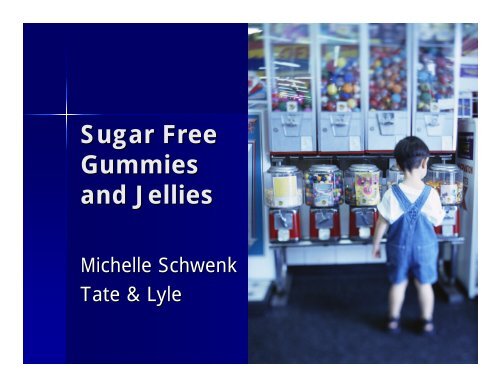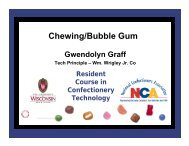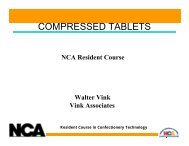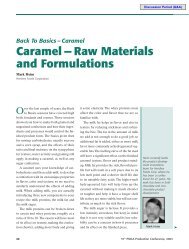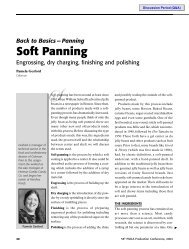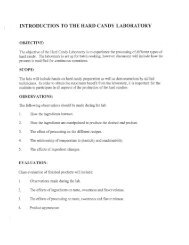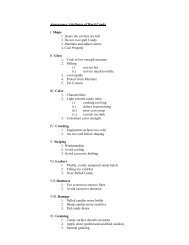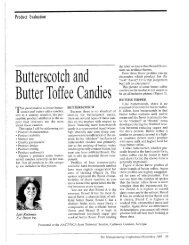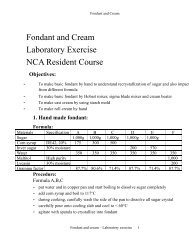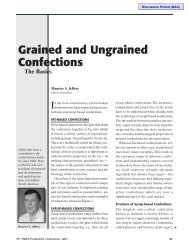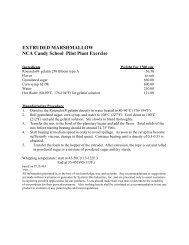Sugar Free Gummies and Jellies - staging.files.cms.plus.com
Sugar Free Gummies and Jellies - staging.files.cms.plus.com
Sugar Free Gummies and Jellies - staging.files.cms.plus.com
You also want an ePaper? Increase the reach of your titles
YUMPU automatically turns print PDFs into web optimized ePapers that Google loves.
<strong>Sugar</strong> <strong>Free</strong><br />
<strong>Gummies</strong><br />
<strong>and</strong> <strong>Jellies</strong><br />
Michelle Schwenk<br />
Tate & Lyle
Formulation<br />
Gelling Agent (s)<br />
Bulking Agent (s)<br />
High Intensity<br />
Sweetener
Gelling Agents<br />
Chosen for cost <strong>and</strong> finished<br />
eating quality (texture)<br />
Starch<br />
– Should be <strong>com</strong>pletely cooked out<br />
Gelatin<br />
– Can have issues with hardening<br />
Pectin<br />
Carrageenan
Bulking Agents<br />
Appropriate for Jelly’s Jelly s <strong>and</strong> <strong>Gummies</strong><br />
Polydextrose<br />
– Chosen for low calories & cost<br />
Maltitol<br />
– Chosen for ease of use <strong>and</strong> formulation<br />
Sorbitol<br />
– Chosen for cost<br />
Other Polyols
New Bulk Ingredients<br />
Fiber Ingredients<br />
– Soluble Corn Fiber<br />
– Resistant Maltodextrin<br />
– Watch for color, <strong>and</strong> solubility <strong>and</strong><br />
viscosity
Hygroscopicity<br />
What makes things hygroscopic?<br />
– Small molecules (low molecular weight)<br />
How do you prevent it?<br />
– Minimize the small molecules<br />
– Increase the large molecules
Calculating max sugars<br />
Limit 0.5g sugar per serving<br />
Serving size 40g<br />
Calculate max sugar %<br />
0.5/40 = 1.25%<br />
Find sugar containing ingredient<br />
Ingredient x = 6% sugars (mono & di saccharides)<br />
saccharides<br />
Max amount of ingredient x that can be used:<br />
1.25/6 = 20%
Typical Formula<br />
Pressure cooker<br />
Maltitol Syrup %<br />
66.6<br />
Polydextrose 11.0<br />
Thin Boiling Starch 10.0<br />
Water 12.4<br />
100.0<br />
Add color, flavor <strong>and</strong> acid as desired after<br />
cooking
High Intensity<br />
Sweeteners<br />
Heat stable HIS’s HIS can be added up front<br />
– i.e. sucralose<br />
Use level depends on the bulking agents<br />
– 25ppm can enhance overall likeability<br />
Less sweet bulking agents will require a HIS
Mixing<br />
Procedure<br />
Cooking<br />
Flavoring<br />
Depositing<br />
Curing<br />
Finishing
Mixing<br />
Bulking agents may be difficult to<br />
dissolve<br />
– Solution: use liquids<br />
– Solution: make sure to<br />
mix long enough. Add<br />
hard to dissolve<br />
ingredients first.
Cooking<br />
Recalibrate your<br />
refractometer solids<br />
– Will be different with<br />
different polyols/blends
Pressure Cooking<br />
Procedure<br />
1. Slurry all ingredients, preheat to 180F <strong>and</strong><br />
jet cook at 285F.* 285F.*<br />
2. Add color <strong>and</strong> flavor then deposit at 78- 78<br />
79% solids in hot dry moulding starch.<br />
Hold in starch until adequate gel forms<br />
(up to 48 hours) hours)<br />
<strong>and</strong> piece reaches 84%<br />
solids. solids<br />
3. Shake <strong>and</strong> finish, then dry surface <strong>and</strong><br />
package.<br />
* Cooking temperature 330F for high amylose corn starch
Flavoring<br />
Increased flavor levels may be needed<br />
Change flavors to match bulking<br />
agents or high intensity sweeteners<br />
Add the HIS at the appropriate time<br />
Add acid at this step<br />
– can affect gelling agent
Depositing<br />
Condition starch 5-7% 5 7% moisture<br />
– Prevent starch crust
Curing<br />
Dry down to a<br />
low moisture<br />
content<br />
– Many bulking agents are hygroscopic<br />
– Dry 84-85% 84 85% solids<br />
Drying to the same solids content may<br />
require longer time<br />
– hydroscopic
Finishing<br />
Oiling<br />
– Should be ok<br />
S<strong>and</strong>ing<br />
– What are you going to use?<br />
– Many bulking agents can dissolve on<br />
surface of c<strong>and</strong>y<br />
– Possible solutions: maltitol, isomalt
Packaging<br />
A good moisture barrier is key<br />
– Talk to your packaging supplier<br />
Bulk packaging<br />
– Consider re-seal re seal container
Special Considerations<br />
Cross contamination<br />
– Watch the other products being<br />
manufactured<br />
Long shelf life<br />
– Hygroscopic


